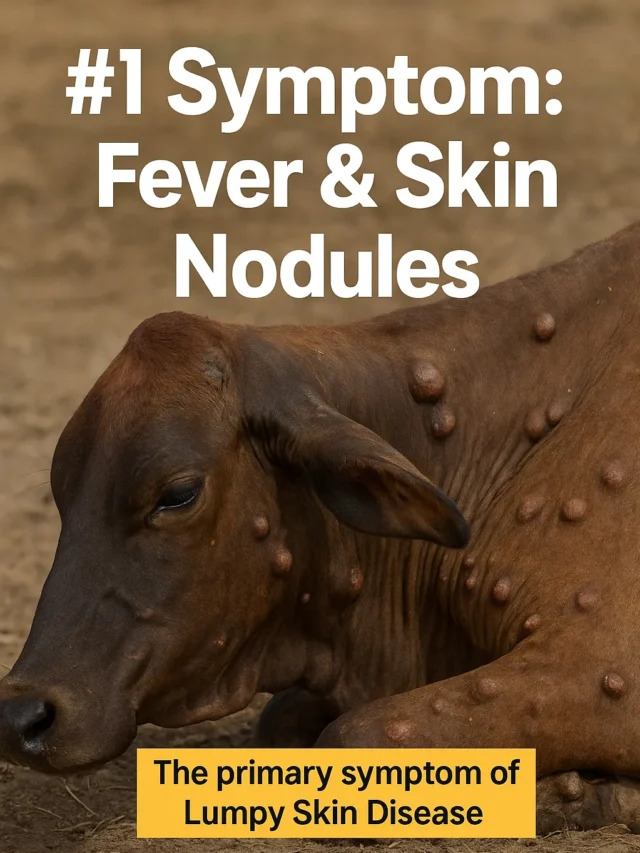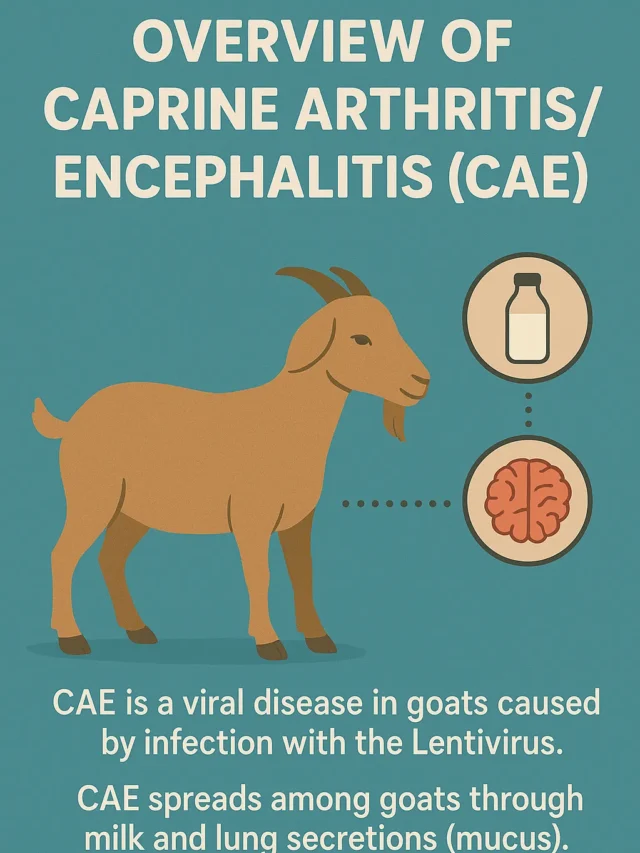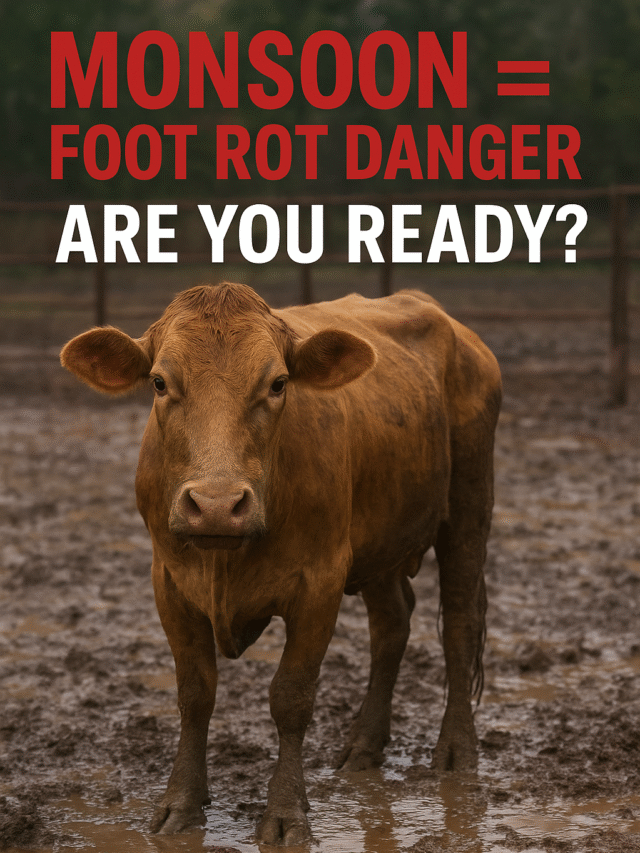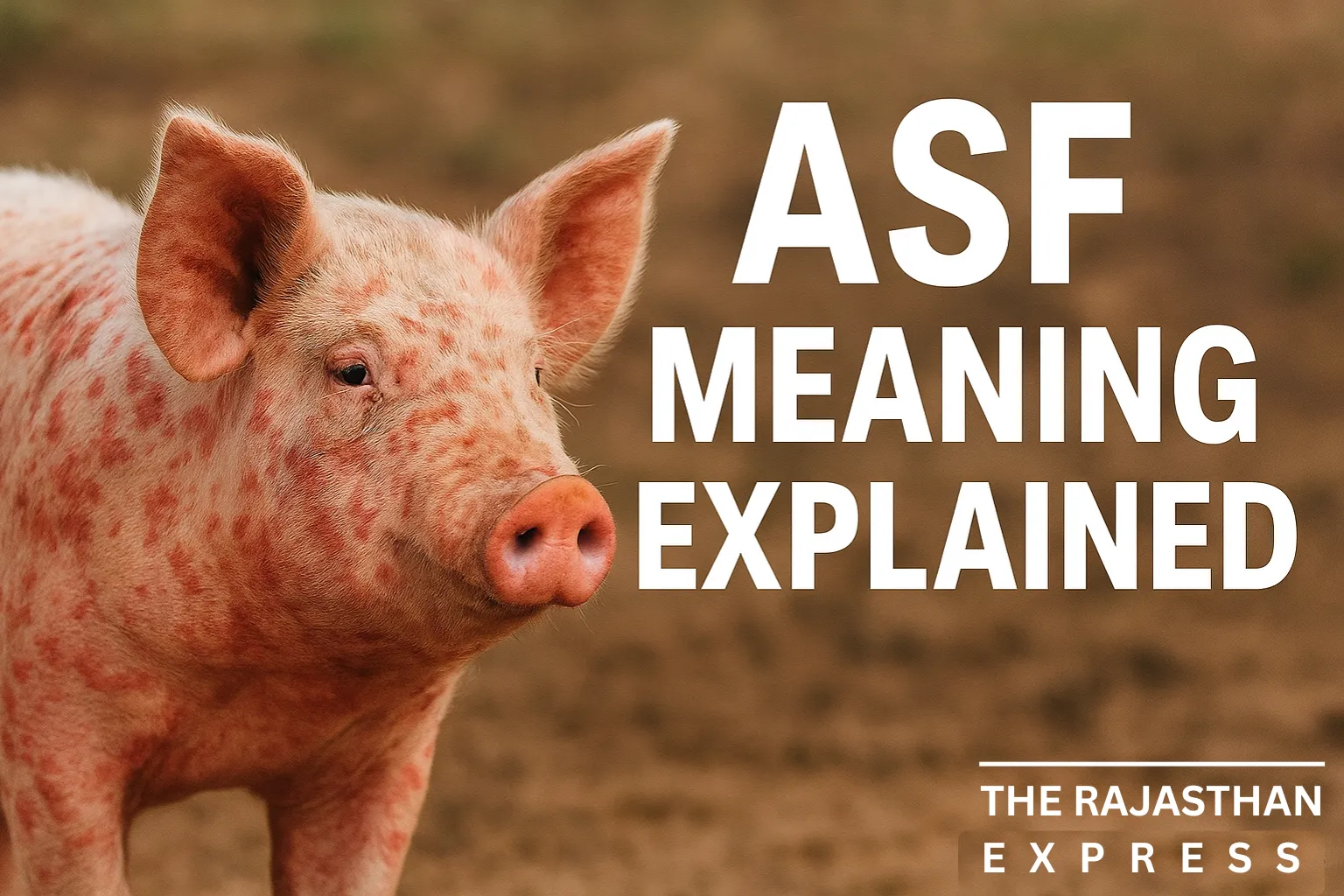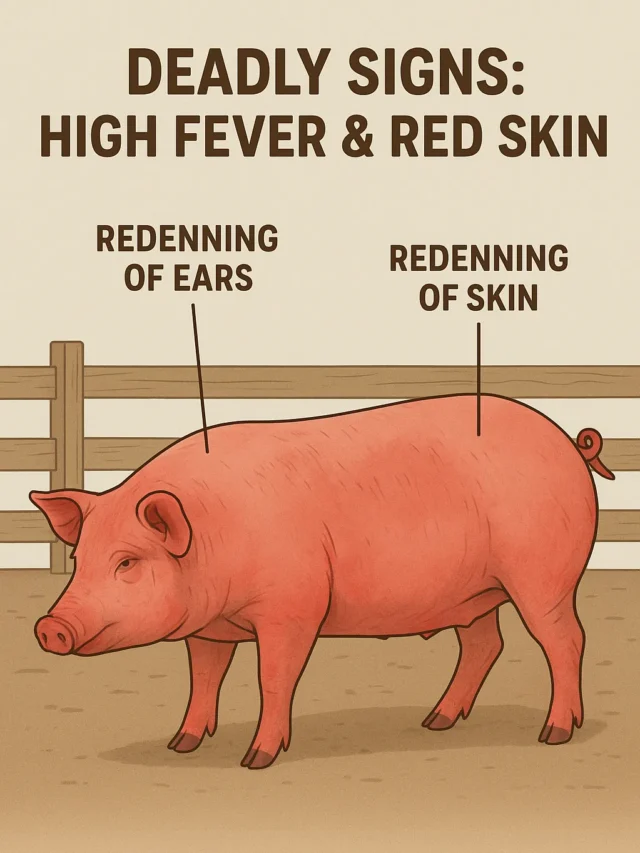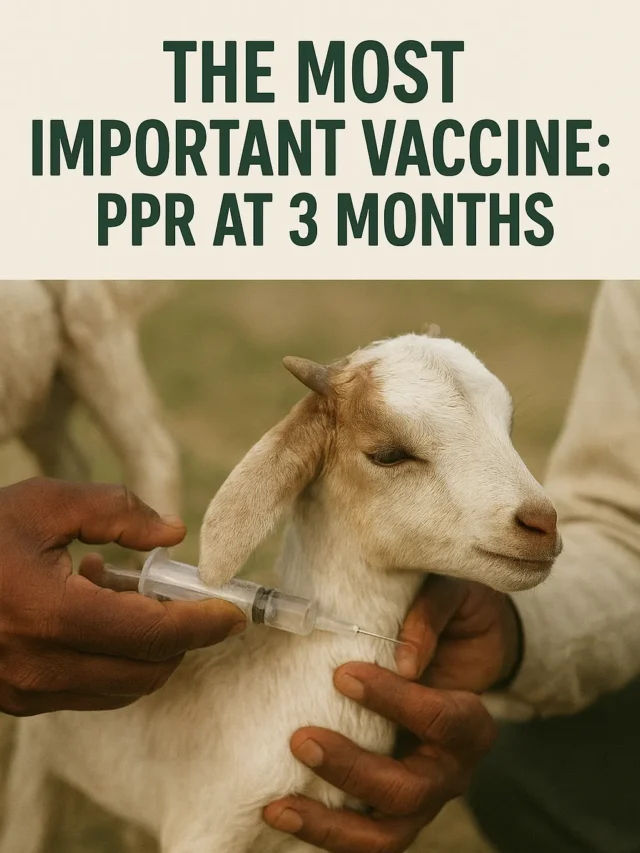What is African Swine Fever (ASF)?
ASF Meaning: ASF means African Swine Fever. It is a contagious viral disease of pigs (both domestic and wild).
African Swine Fever (ASF) is a highly dangerous and contagious viral disease occurring in pigs (both domestic and wild). The African Swine Fever (ASF) disease in pigs is caused by the African Swine Fever Virus (ASFV), which is a DNA virus belonging to the Asfarviridae family and Asfivirus genus. It is the sole member of the Asfarviridae family, setting it apart from most other known viruses. A unique characteristic is that it is the only known DNA arbovirus, meaning it is a DNA virus spread by insects (ticks), while most arboviruses are RNA viruses.
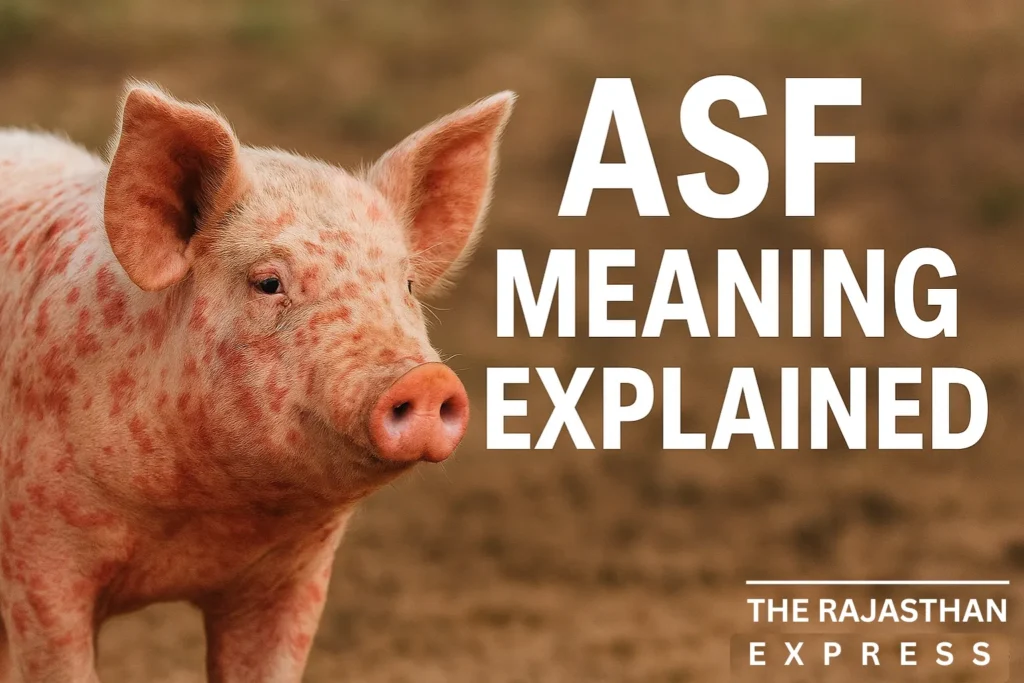
African Swine Fever (ASF) is not a zoonotic disease and therefore poses no danger to humans. However, its mortality rate in pigs is very high (close to 100%). This means that if this disease spreads in a herd, almost all pigs can die, causing massive losses for farmers. African Swine Fever is a notifiable disease because it is highly contagious, causes high mortality in pigs, and has a devastating impact on the global swine industry. It is listed by the World Organisation for Animal Health (WOAH) (formerly OIE) and must be reported immediately to higher authorities to prevent its spread.
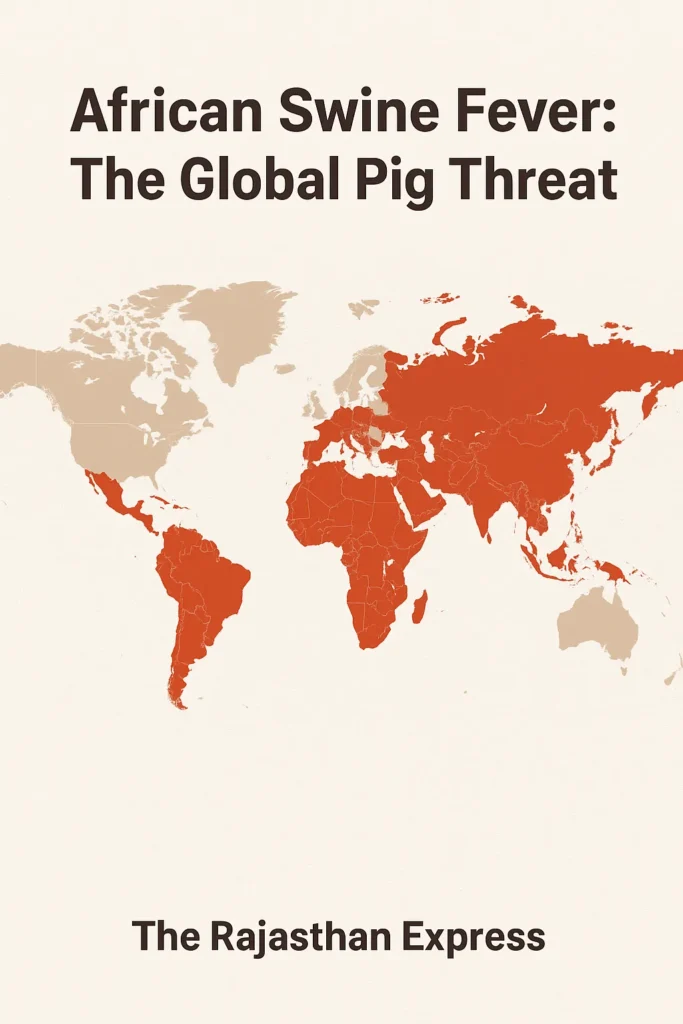
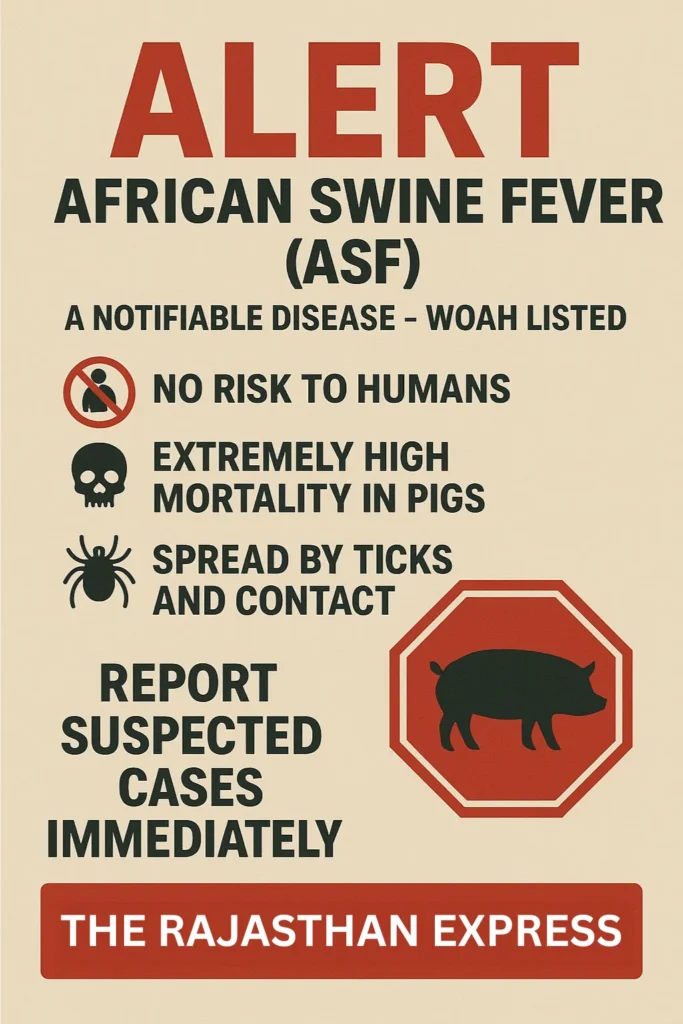
African Swine Fever (ASF)
| Other Names / Synonyms | Wart Hog Disease, African Pig Disease, East African Swine Fever | ||||||||||||||||||||||||||
|---|---|---|---|---|---|---|---|---|---|---|---|---|---|---|---|---|---|---|---|---|---|---|---|---|---|---|---|
| Causes | Infection by the African Swine Fever Virus (ASFV) | ||||||||||||||||||||||||||
| Pathogen | African Swine Fever Virus (ASFV) – a large, double-stranded DNA virus. It is the sole member of the Asfarviridae family and the only known DNA arbovirus (arthropod-borne virus). | ||||||||||||||||||||||||||
| Pathology | Virus targets immune cells (macrophages, dendritic cells) via receptors like CD163, causing massive apoptosis (cell death) and disabling the host’s immune response. This leads to a cytokine storm, widespread vasculitis (blood vessel damage), hemorrhage, and multi-organ failure. Key mechanisms include immune evasion (e.g., p22 protein destroying interferon receptors) and Antibody-Dependent Enhancement (ADE). | ||||||||||||||||||||||||||
| Immune Evasion (Latest Research) |
ASFV has evolved multiple strategies to subvert host defenses:
| ||||||||||||||||||||||||||
| Types / Classifications |
| ||||||||||||||||||||||||||
| Symptoms |
Acute Form (High Mortality):
Incubation Period | 4–19 days in natural infections (average 5–10 days), shorter (2–5 days) in acute experimental infections. | Transmission | Risk Factors | Diagnosis | Treatment Options | There is no specific treatment or cure for African Swine Fever. Supportive care (fluids, anti-inflammatories) may alleviate symptoms but does not affect the outcome. Infected herds are typically culled to control spread. | Prevention Methods | Complications | Prognosis |
Domestic pigs: Mortality up to 100% (acute). | Wild African suids (warthogs, bushpigs): Asymptomatic carriers. Frequency / Prevalence | Endemic in sub-Saharan Africa. Since 2007, it has spread to Europe, Asia (causing a major pandemic from 2018), and the Caribbean. As of 2024, it is present in over 50 countries across Africa, Europe, Asia, and Oceania, affecting millions of pigs. | Affected Population | History / Discovery | First described in Kenya in 1921. The virus was first isolated and identified by Montgomery in 1921. The role of Ornithodoros ticks as a biological vector was established in the 1960s. The ongoing global pandemic, driven by ASFV Genotype II, began in Georgia in 2007 and spread rapidly to Europe and Asia from 2018 onward. | Vaccine Status | As of late 2024, there is no commercially available globally licensed vaccine. Several candidate vaccines (e.g., live-attenuated, subunit) are in advanced stages of research and development, but challenges related to safety, efficacy, and cross-protection against multiple strains remain. | Sources: World Organisation for Animal Health (WOAH), Food and Agriculture Organization (FAO), European Food Safety Authority (EFSA), The Merck Veterinary Manual, peer-reviewed research (2024-25), and The Rajasthan Express. | | |||||||
Pathogen and Etiology: What Causes African Swine Fever?
Understanding the causative agent of African Swine Fever is crucial for control and prevention.
- ASF Meaning : African Swine Fever (ASF)
- Causal Agent: African Swine Fever Virus (ASFV).
- Classification: The African Swine Fever virus (ASFV) is a large, complex DNA virus. It is the sole member of its own separate family, Asfarviridae, which distinguishes it from most other known viruses.
- Characteristic: A unique feature is that it is the only known DNA arbovirus, meaning it is a DNA virus spread by insects (ticks), while most arboviruses are RNA viruses.
- Stability: This virus is highly stable in the environment. It can survive for long periods in cold temperatures and various pH conditions, especially if organic matter (blood, feces) is present. It remains infectious in undercooked or dried pork products for several months.
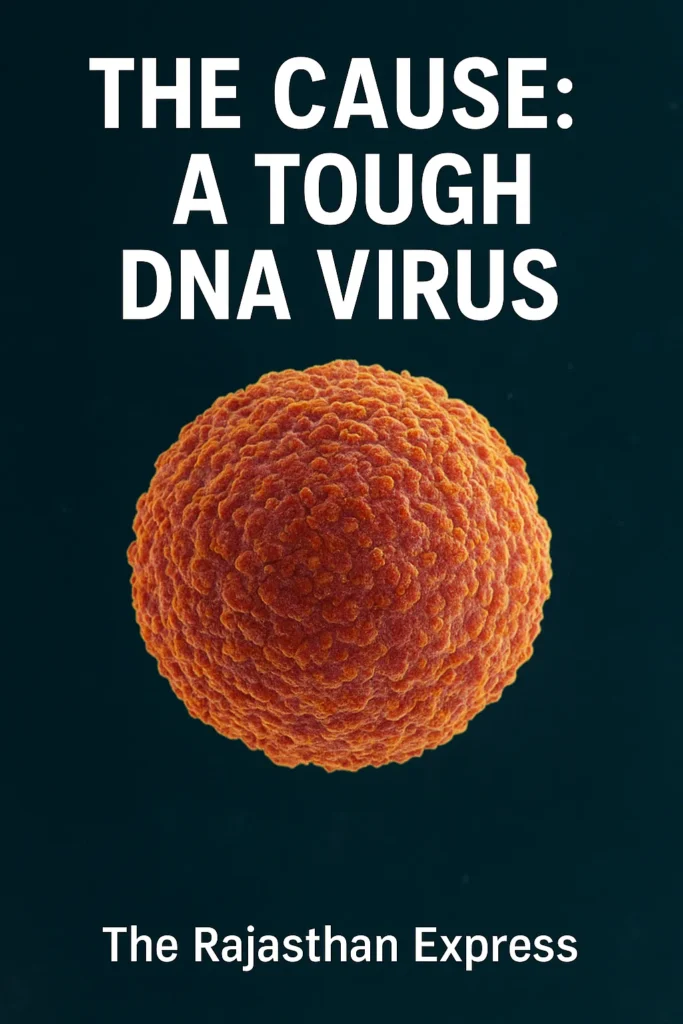
Virus Classification and Genetic Diversity
Scientific Fact: The large genome (approximately 170-190 kbp) and high genetic diversity of the African Swine Fever virus (ASFV) make it challenging. Genotype-I of ASFV spread in Europe and America in the past decade, while Genotype II has been the major genotype spreading in China, Europe, and Asia in recent years. Research indicates that even within Genotype II, new subtypes (subgroups) are emerging, which is an obstacle for vaccine development.
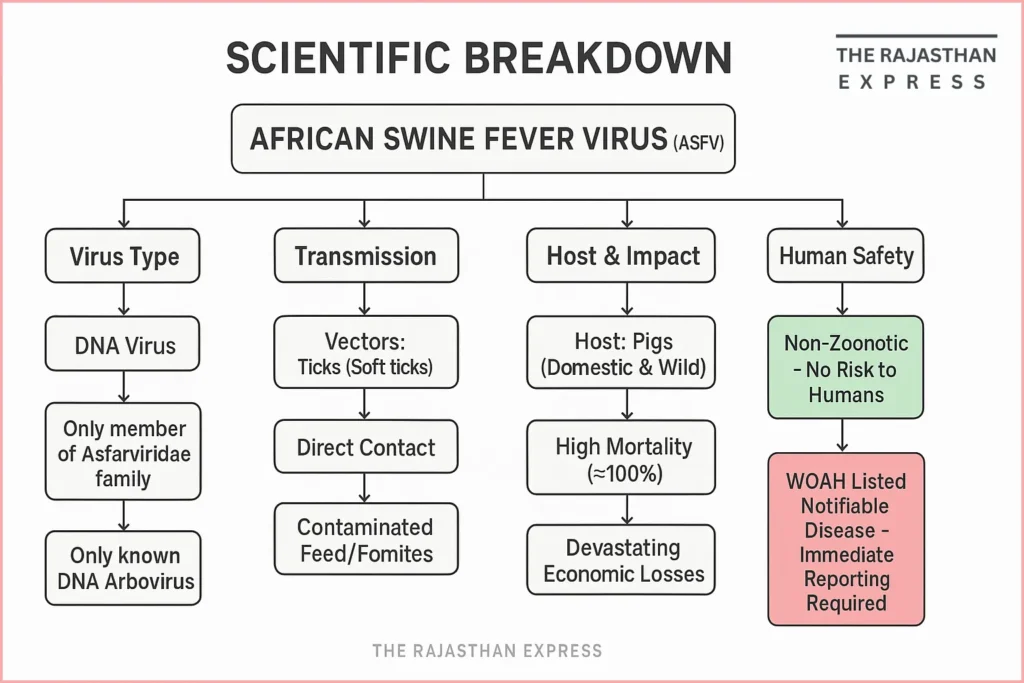
African Swine Fever Virus: How Resilient Is It?
ASFV is an extremely tough and stubborn virus. It can survive for weeks and months outside the pig’s body and spread the disease. Understanding it is the first step to overcoming it.
1. Effect of Temperature
- Unaffected by Cold: ASFV is not at all bothered by the cold. The virus can remain safe and infectious for several months in meat, blood, or other products stored in a refrigerator or freezer. This is why the import of contaminated pork products is a major risk. Research has confirmed that ASFV can remain infectious for several months in uncooked prepared pork products (such as dried ham, salami). This is why preventing the smuggling of pork products at international airports is a key prevention strategy.
- Weakened by Heat: The virus does not like heat at all. It requires consistent, high heat to be killed.
- 56°C Temperature: If something is heated continuously at 56°C for 70 minutes (over 1 hour), the virus dies.
- 60°C Temperature: If the temperature is increased to 60°C, it takes only 20 minutes for the virus to die.
Easy Takeaway:
- Danger: Undercooked or raw pork (like salami, ham, sausage) is dangerous because the cooking temperature is not sufficient to kill the virus.
- Prevention: Cook pork thoroughly so that its internal part is well heated. This completely destroys the virus.
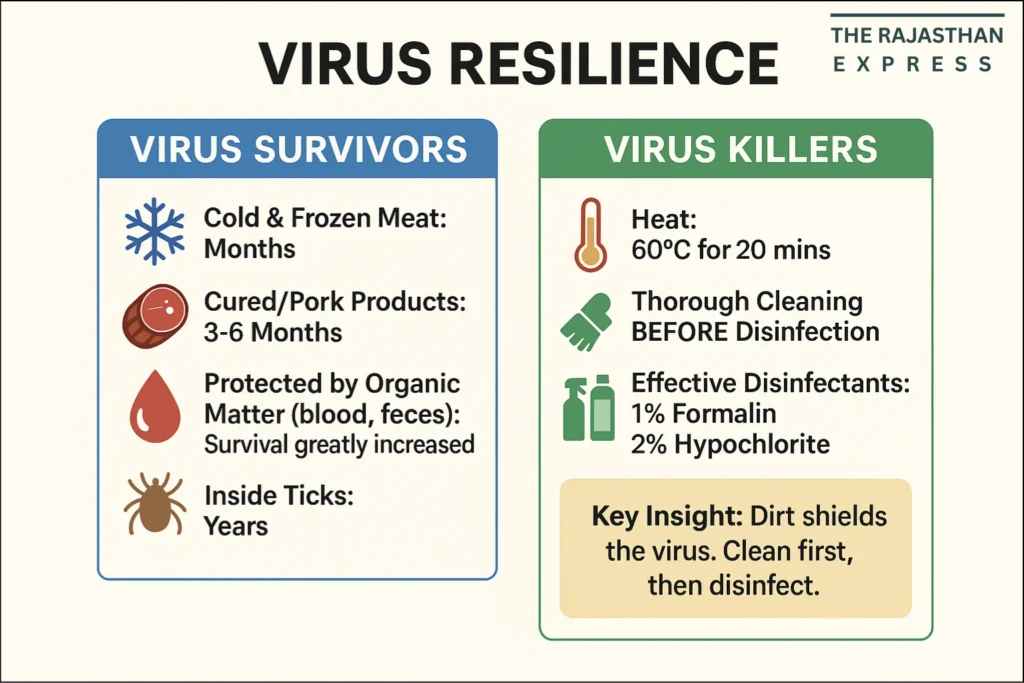
2. Effect of pH – Acid and Base
- What is pH? This scale indicates whether something is acidic (sour) or alkaline (salty/soap-like).
- ASFV’s Preference: This virus does not like a very acidic environment nor a very alkaline one.
- Without Protection (without blood/serum): If the virus is in pure water or a clean medium, it dies quickly.
- With Protective Shield (in the presence of blood/serum): Serum is a part of blood. If blood, serum, or any other organic matter (like feces, pus) is present around the virus, it acts as a protective shield for it. Disinfectants (like chlorine, caustic soda, sodium hypochlorite) are effective, but the quantity of organic load (organic matter) such as blood, serum, pus, etc., significantly reduces their capacity. Research emphasizes that cleaning surfaces thoroughly before using disinfectant is extremely important. Recent studies also show the limited effectiveness of some commercial disinfectants (like quaternary ammonium compounds), hence the emphasis is on using official disinfectants (as recommended by W.H.O.).
Example: In a highly alkaline (pH 13.4) environment:
- Without serum, the virus survived for only 21 hours.
- With serum present, the same virus could survive for 7 days!
Easy Takeaway:
- Danger: If there is blood, feces, or other dirt accumulated on the farm, the disinfectant cannot work completely because the dirt protects the virus.
- Prevention: The area should be cleaned and washed thoroughly before spraying disinfectant so that the virus’s protective shield is removed.
3. Survival Capacity in Different Conditions
This virus is like a “superbug” and shows its strength:
- Infected Products: It can survive for 3 to 6 months in infected pig meat, blood, bone meal, etc. This is the biggest reason for the spread of this disease worldwide.
- In Farm Dirt: The virus can survive for several days to weeks in the feces, urine, or bedding of an infected pig.
- Inside Ticks’ Bodies: This virus not only survives but also multiplies inside the bodies of Ornithodoros ticks and can live in them for years. The tick acts as a “living needle” that delivers the virus from one pig to another. The virus can undergo transovarial (from female tick to her eggs) and transstadial (from one life stage to another) transmission. The role of ticks in the spread of ASF among wild boars in Europe is still a subject of research, but this cycle is clearly established in Africa.
Summary – Scientific Truth and Practical Advice
- Heat is a Friend: Cook meat thoroughly. Heat is the virus’s biggest enemy.
- Cleanliness is Essential: Before using disinfectant, clean the farm, vehicles, and equipment thoroughly to remove dirt.
- Cold Meat is a Danger: Prevent raw or undercooked pork products from coming into contact with pigs. The practice of feeding waste is dangerous.
- Keep an Eye on Ticks: Wherever possible, control ticks.
Conclusion: ASFV is very strong, but by knowing its weakness, we can control it. Cleanliness, heat, and strict biosecurity are our biggest weapons against it.
Current Status of African Swine Fever Vaccine Development
Scientific Fact: It is correct that there is no licensed vaccine in the market. However, research is progressing rapidly. Live-Attenuated Vaccines (LAVs) appear to provide some protection, but they carry the risk of side effects. Work on subunit vaccines is ongoing, which could be safer, but they have not yet been successful in providing complete protection. The biggest challenge in African Swine Fever vaccine development is the virus’s ability to evade the immune response.
“For the latest developments in disease prevention across various species, read our detailed article on ‘the world’s first single-dose vaccine developed to protect koalas from chlamydia’ here → World’s First Koala Chlamydia Vaccine Approved ←.”
Pathogenesis of African Swine Fever
African Swine Fever (ASF) is a fierce hemorrhagic disease in pigs. The virus enters the body and attacks the immune system and blood vessels, resulting in severe symptoms and often a mortality rate reaching 100%. The pathogenesis process of the African Swine Fever virus (ASFV) is extremely complex and clever, functioning like a planned attack. Its primary targets are those cells of the pig’s immune system that are normally responsible for fighting infection, particularly macrophages and dendritic cells. The virus not only destroys these cells but also “hacks” the body’s defense mechanism to use it to its advantage, resulting in a condition of severe hemorrhage and inflammation.
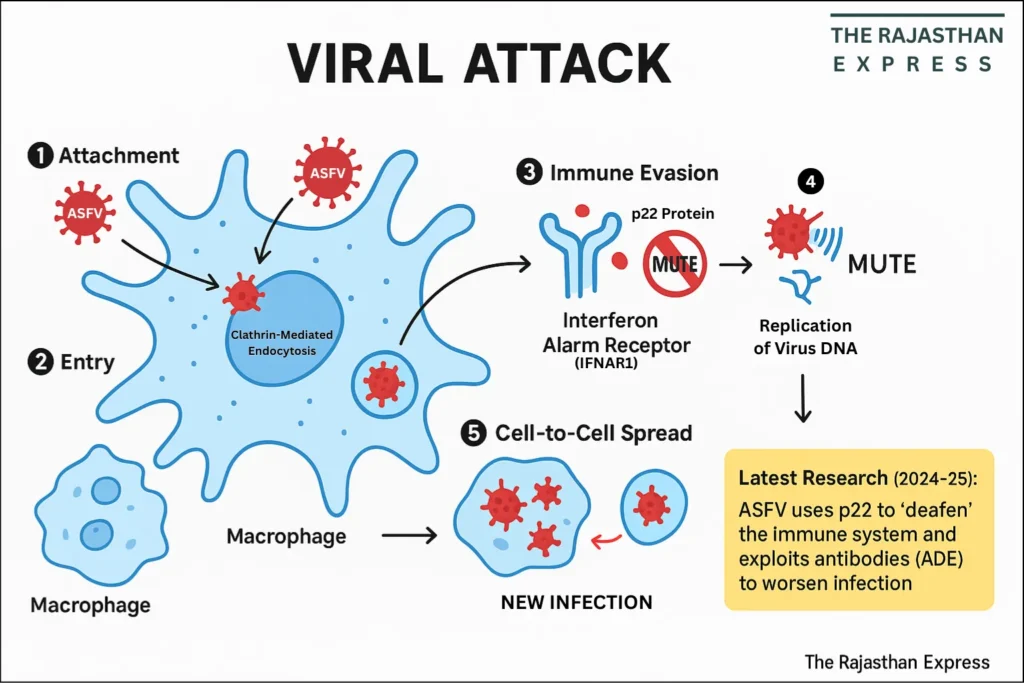
- Viral Entry: ASFV recognizes specific receptors (like CD163) present on the surface of immune cells such as macrophages. Once bound, it enters the cell inside a small bubble (vesicle) created by the cell membrane. This process is called clathrin-mediated endocytosis. This step is crucial as it demonstrates the virus’s cell specificity (Tropism) – it directly attacks the very cells that are supposed to fight it.
- Immune Evasion: Once inside the cell, the virus’s most clever strategy begins: disabling the immune system. Recent research (2024-25) has shed new light on this. It has been discovered that a special protein of ASFV, called p22, destroys the host cell’s interferon receptor (IFNAR1). Interferon is the body’s “security alarm” system, which alerts nearby cells about the infection. The destruction of this receptor prevents the cell from receiving this warning signal, meaning it does not get the signal to fight the virus. This gives the virus ample time to spread unchecked.
- Replication Cycle: ASFV’s DNA begins to multiply directly in the cytoplasm, without going into the nucleus. The virus uses the cell’s resources to produce its own DNA and proteins, from which new virus particles are formed. This process renders the cell completely dysfunctional and ultimately causes its death.
- Cell-to-Cell Spread: New virus particles need an efficient mechanism to spread throughout the body, and ASFV has that too. Research has shown that the virus prompts infected macrophages to “eat” (phagocytose) the pieces of dying infected cells. When macrophages eat those pieces containing the virus, they themselves become infected. In this way, the virus spreads rapidly in the body through cell-to-cell transmission, without spending much time in the bloodstream.
- Antibody-Dependent Enhancement (ADE): Another startling discovery is that of Antibody-Dependent Enhancement. 2025 research has revealed that some antibodies produced against a specific virus protein (pA137R) can actually worsen the infection. These antibodies “help” the virus enter immune cells more easily, making the disease more severe. This is a major challenge for African Swine Fever vaccine development.
The cumulative result of all these processes is the complete collapse of the body’s immune system. The walls of blood vessels are damaged, causing widespread hemorrhage. An unbalanced level of inflammatory molecules (cytokines) can create a cytokine storm, leading to organ failure. Ultimately, this complex and planned attack proves fatal for the pig.
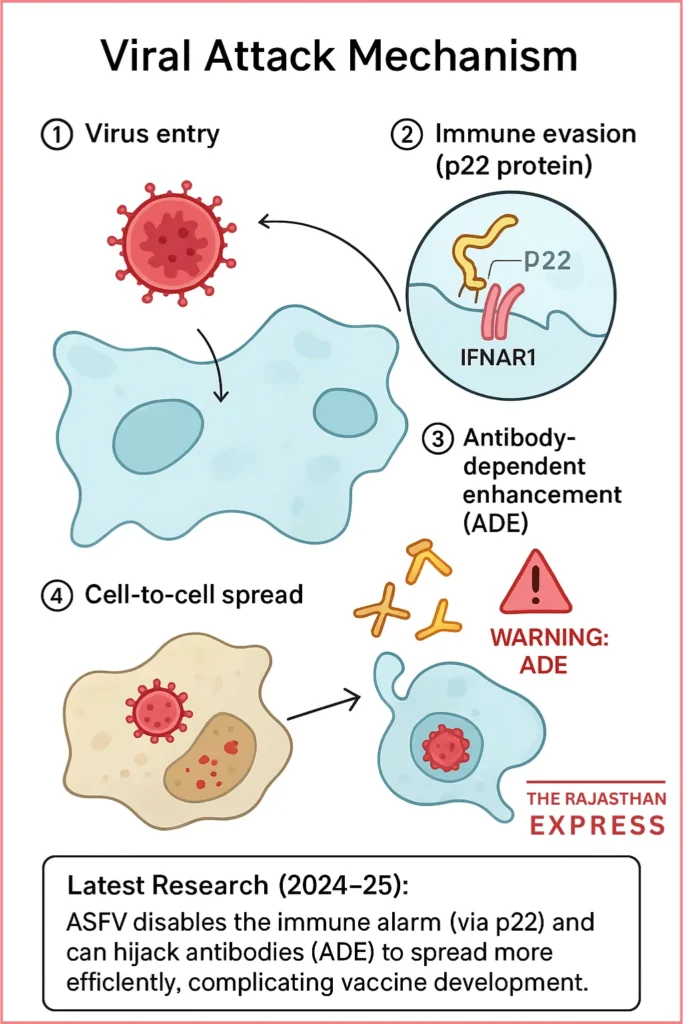
African Swine Fever Symptoms: A Detailed Clinical Picture
The clinical signs of African Swine Fever vary based on the severity of the disease.
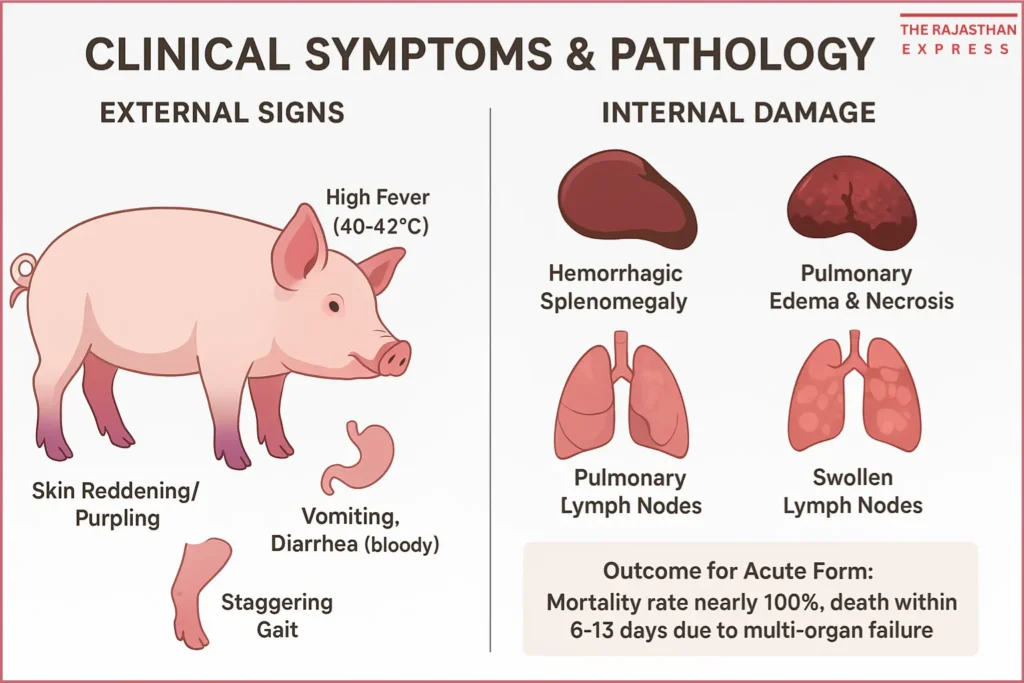
| African Swine Fever Symptoms: A Detailed Clinical Picture | ||
| Symptom Type | Detailed Symptoms | What Happens in the Body? (Pathophysiology) |
|---|---|---|
| General Symptoms | High fever (40-42°C), not eating, lethargy, weakness, huddling together. | Due to the body’s response to the virus and widespread infection of the immune system. |
| Respiratory | Difficulty breathing, coughing, nasal discharge. | Fluid accumulation in the lungs (pulmonary edema) and inflammation in the respiratory tract. |
| Digestive | Vomiting, diarrhea (sometimes bloody). | Damage to the intestinal lining and bleeding. |
| Dermatological | Reddening/purpling of the skin, especially on ears, snout, abdomen, and legs. Small bleeding marks (Cutaneous ecchymoses). | Damage to blood vessels (vasculitis) and disruption of the blood clotting process. |
| Reproductive | Abortion in pregnant sows. | The virus reaching the fetus and harming it. |
| Neurological | Staggering gait, inability to stand. | Effect on the nervous system in advanced stages. |
| Outcome (Acute Form) | Death within 6-13 days. Mortality rate nearly 100%. | Complete collapse of the body’s immune system and multi-organ failure. |
| The Rajasthan Express : African Swine Fever Symptoms | ||
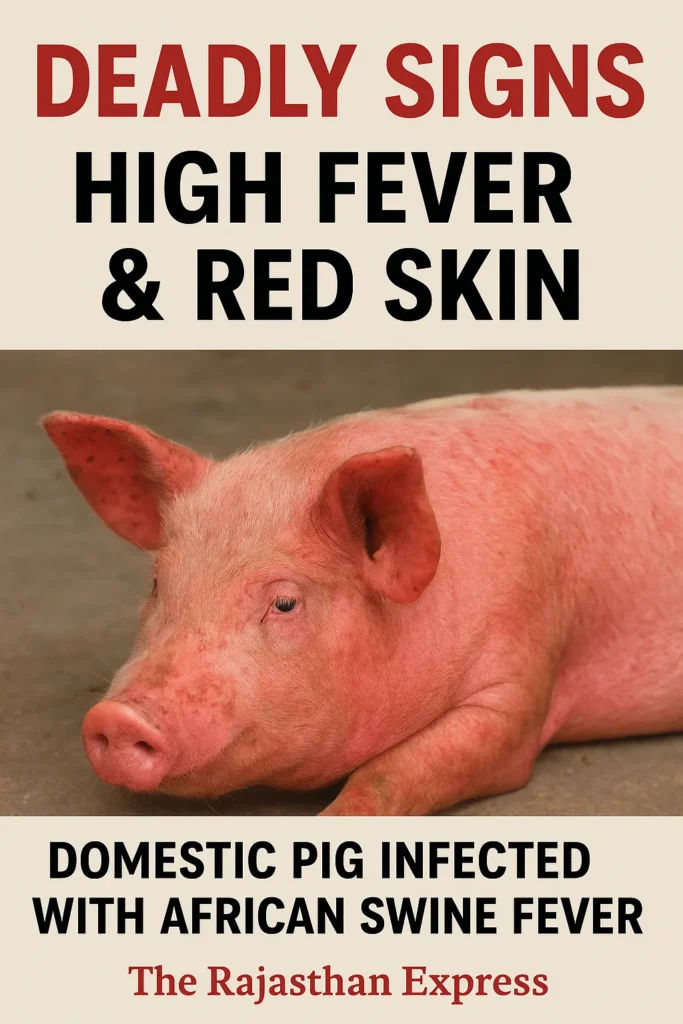
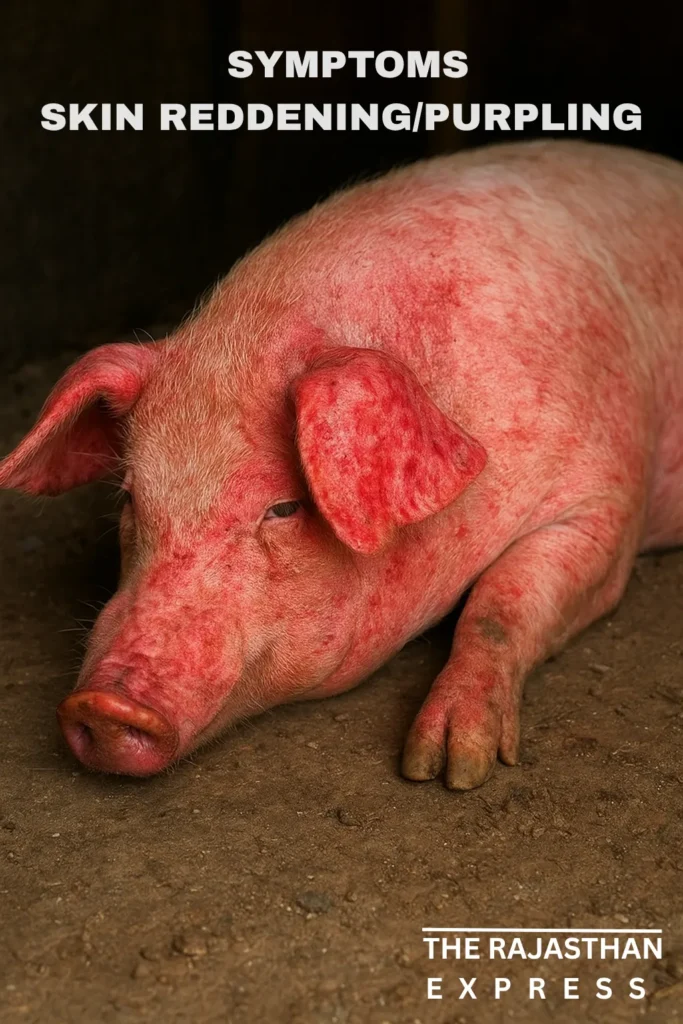
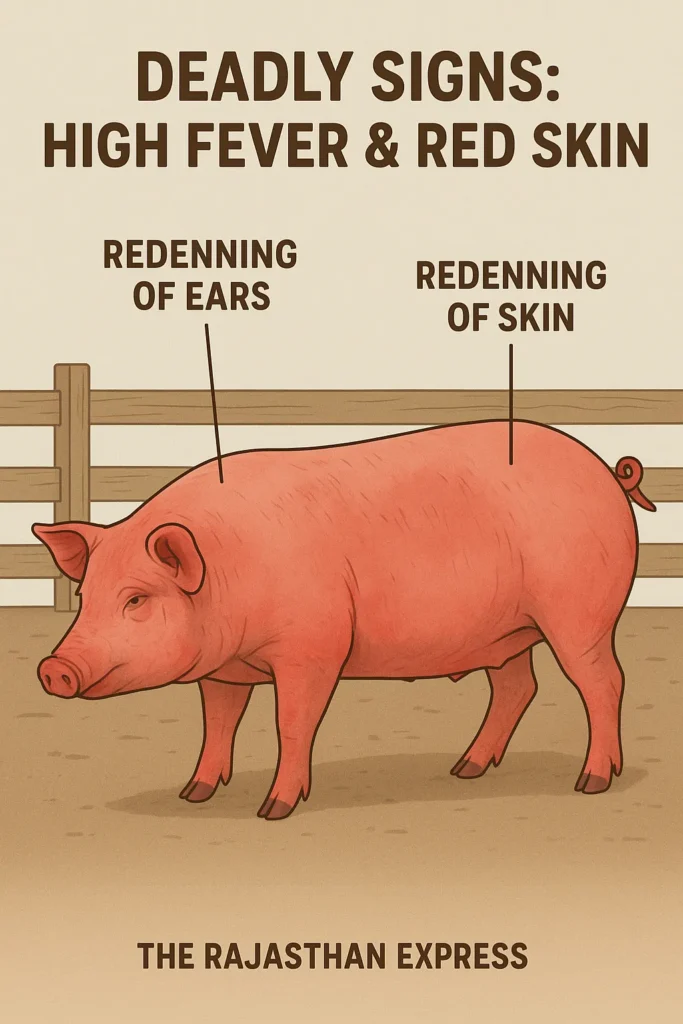
African Swine Fever Symptoms (Chronic Form)
This is a long-term and mild form of the ASF disease. In the acute form, pigs die within a few days, but in the chronic form, pigs can survive for months, but they remain sick and weak.
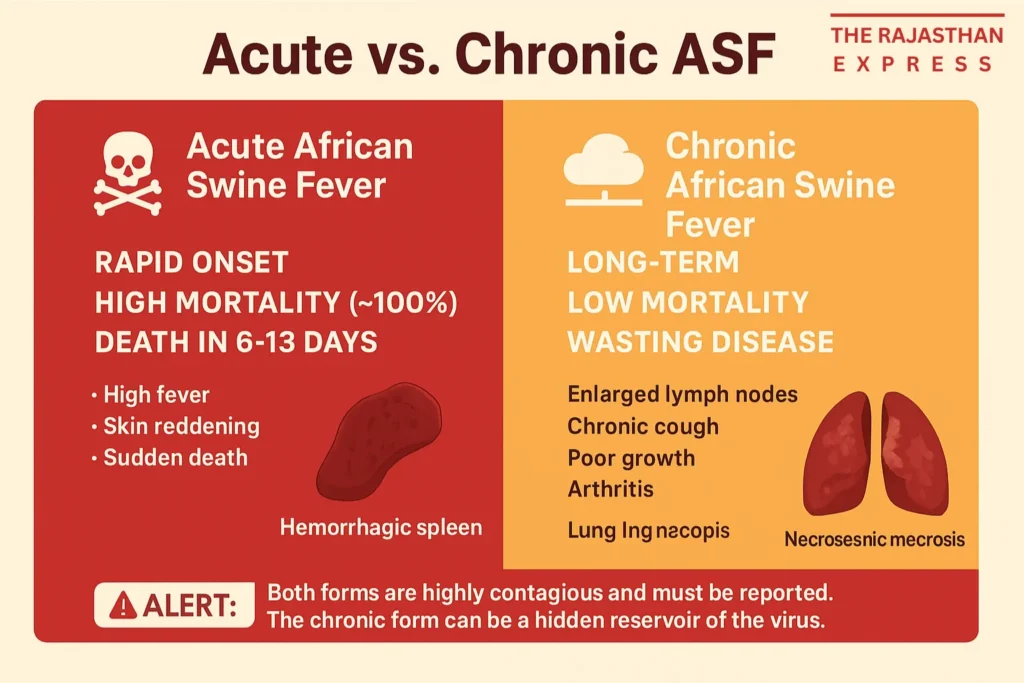
- Enlarged Lymph Nodes: Lymph nodes are the body’s defense outposts, i.e., lymphoid organs that help develop immunity. When viruses, bacteria, or parasites constantly attack them, they swell and become very large. This indicates that the body is constantly fighting the infection but is unable to win.
- Lung Cell Death:
- Necrosis: Tissues inside the lungs begin to die and a thick, cheese-like, white-yellow substance begins to form.
- Mineralization: Calcium and other minerals deposit in the lungs, causing them to become hard and stony.
- Result: The pig has difficulty breathing, it coughs, and is unable to grow properly.
Lesions Found on Post-Mortem Examination
The internal damage to the body is even more severe:
- Hemorrhagic Splenomegaly: The spleen, which is a reservoir of immune cells, becomes severely damaged by the virus’s attack, swells to many times its size, and appears black due to hemorrhage.
- Swollen Lymph Nodes: Lymph nodes throughout the body swell and appear marble-like due to hemorrhage.
- Internal Hemorrhage: Small and large bleeding marks appear on the kidneys, heart, intestines, and lungs.
- Fluid in Lungs: The lungs may be filled with fluid and swollen.
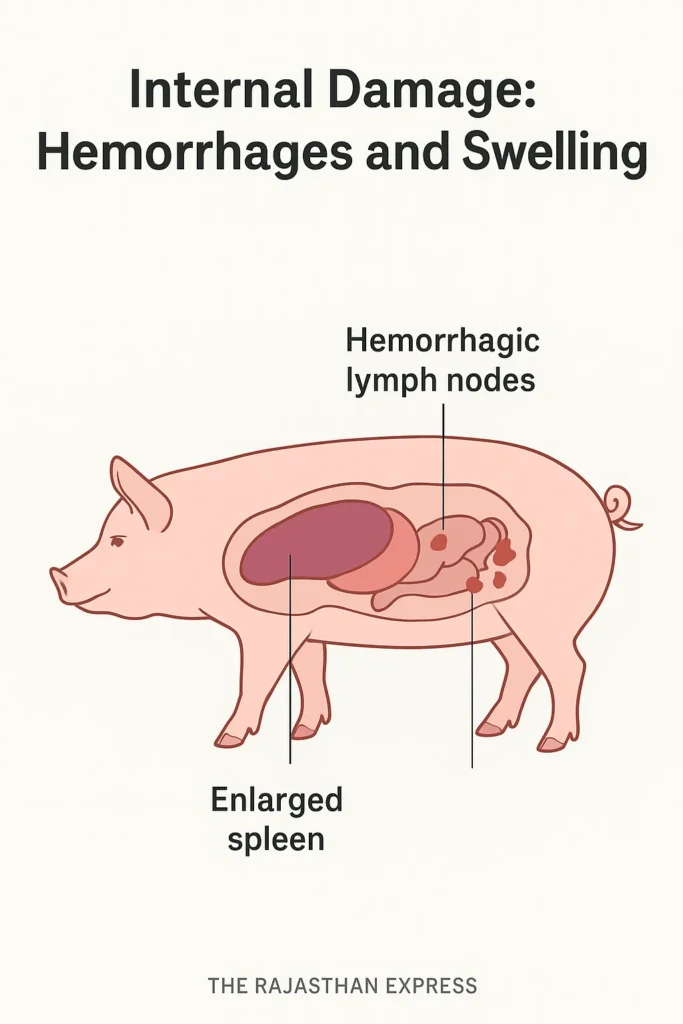
Key Findings from Latest Research Reports (2024-25)
Recent research has provided a deeper understanding of how the ASF virus targets the body:
- Making the Immune System “Deaf” (Immune Evasion): 2024-25 research revealed that a special protein (p22) of the ASF virus destroys the host cell’s interferon receptor (IFNAR1). Interferon is the body’s “security alarm” system. The destruction of this receptor prevents the cell from receiving the signal to fight the virus, allowing the virus to spread uncontrollably.
- Antibodies Can Increase the Danger (ADE): A startling discovery is that some antibodies produced against specific virus proteins (like pA137R) can actually make the infection more severe. This is a major challenge for vaccine development because it means that just producing antibodies is not enough; it is essential to ensure that those antibodies are of the right type and do not worsen the disease.
- Cunning Strategy for Spreading Between Cells (Cellular Transmission): Researchers found that the virus prompts infected immune cells called macrophages to “eat” (phagocytose) the pieces of dying cells. When these macrophages eat the pieces containing the virus, they themselves become infected. This way the virus easily spreads to new cells.
- Emphasis on Rapid Diagnostics: Currently, there is an emphasis on fast and accurate diagnosis for rapid control of outbreaks. Using portable genome sequencing tools (like Oxford Nanopore), the virus strain from samples can now be identified on the farm itself, making it easier to trace the source of infection.

Source: This information is based on recent reports from the World Organisation for Animal Health (WOAH), the European Food Safety Authority (EFSA), and peer-reviewed scientific research papers published in 2024-25 (such as research papers published in “Journal of Virology”, “Veterinary Research”, and ‘Cell Host and Microbe’).
Conclusion and Key Takeaways on African Swine Fever Prevention
The pathogenesis of ASF is extremely complex, where the virus works by deceiving and disabling the host’s immune system. New research is helping us better understand its tricks and aiding in the development of more effective vaccines and treatments in the future. For now, strict African Swine Fever prevention through biosecurity is the only defense.
In Summary:
- For Humans: There is no risk of African Swine Fever in humans, (Non Zoonotic Disease) and pork is safe to eat if cooked thoroughly.
- For Farmers: Focus on strict biosecurity, proper cooking of swill, and immediate reporting of symptoms.
- Globally: Controlling the spread of ASF requires international cooperation to manage its presence in African Swine Fever countries and prevent cross-border transmission.
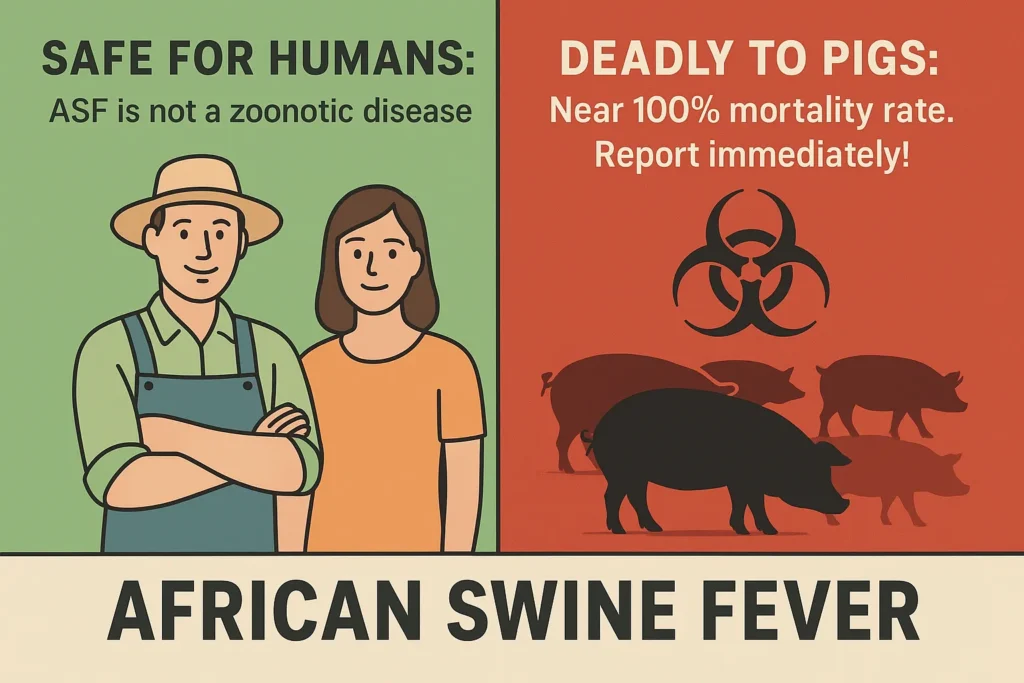
African Swine Fever (ASF): Diagnosis, Transmission, and Prevention Guide
Understanding how to diagnose, contain, and prevent African Swine Fever is critical for protecting swine populations worldwide. This comprehensive guide delves into the differential diagnosis, advanced laboratory testing, transmission cycles, and robust biosecurity measures needed to combat this devastating disease, incorporating the latest 2024-25 research.
Differential Diagnosis for African Swine Fever
What does differential diagnosis mean?
It simply means – “Is it African Swine Fever (ASF) or some other disease?”
The symptoms of ASF (such as high fever, red-blue skin spots, sudden deaths) are similar to many other diseases. It cannot be said for certain just by looking at the external signs that it is ASF. Therefore, doctors make a list of all possible diseases whose symptoms look similar.


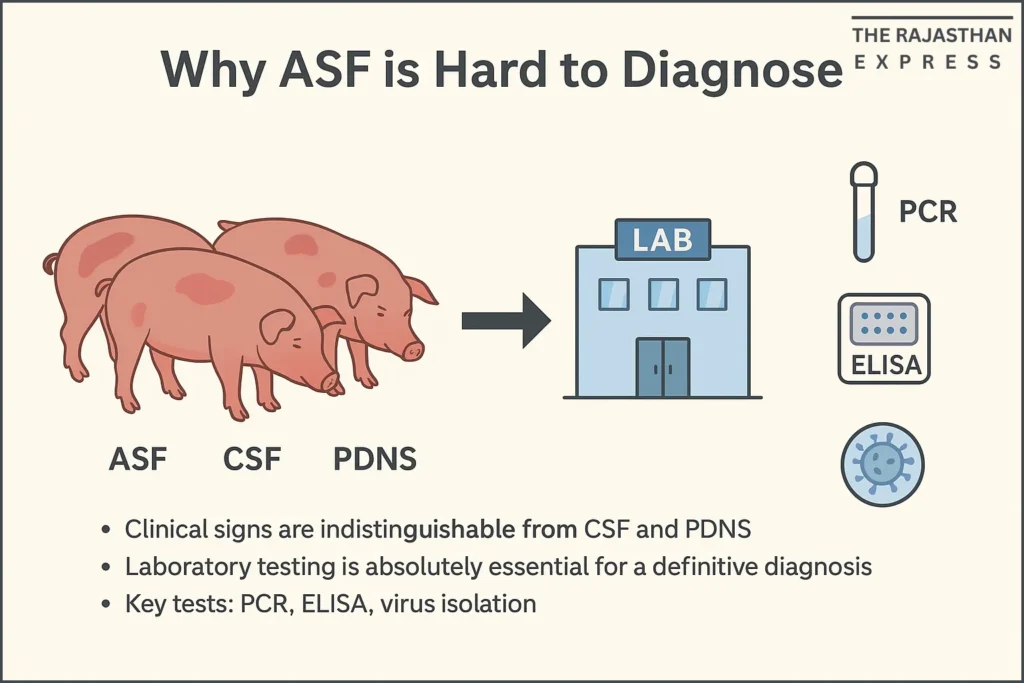
The main diseases that resemble ASF are:
- Classical Swine Fever (CSF): This is the number one mimic of ASF. Both the symptoms and mortality rate are almost identical.
- Note: For a doctor or veterinarian, it is impossible to differentiate between ASF and Classical Swine Fever based on symptoms alone. Laboratory testing is the only way.
- Porcine Reproductive and Respiratory Syndrome (PRRS): This also shows symptoms like difficulty breathing in pigs and abortion in pregnant sows.
- Erysipelas: In this, diamond-shaped red rashes appear on the pig’s skin, which are similar to ASF’s skin spots.
- Salmonellosis: This is spread by bacteria and, like ASF, causes fever and damage to internal organs.
- Aujeszky’s Disease: This primarily causes neurological symptoms (such as seizures, circling) in small piglets.
- Pasteurellosis: This is mainly a respiratory disease, but some of its symptoms can be similar to ASF.
If pigs show symptoms like African Swine Fever, it is essential to understand that it could be ASF, or it might not be. Therefore, testing should be done immediately in a laboratory.
Laboratory Diagnosis: Confirming African Swine Fever
What does laboratory diagnosis mean?
It means going to the lab to confirm that the disease is indeed African Swine Fever. For this, some samples from the sick pig’s body are sent to the lab.
Samples to Collect
There are two types of tests in the lab:
- Virus Detection: To find out if the virus is present in the body.
- Antibody Detection: To find out if the pig’s body has produced antibodies to fight the virus.
- Samples for Virus Detection (during the early stage of the illness):
- Blood: A blood sample is taken in a special tube (EDTA tube).
- Organs: Samples of the spleen, lymph nodes, tonsils, kidney, lungs, and bone marrow are taken from a dying or dead pig. These are sent to the lab cooled (on ice).
- Samples for Antibody Detection (8-21 days after the illness):
- Serum: Blood is taken from pigs that are recovering from the disease, and their serum is separated.
Tests Conducted in the Lab
A. Tests for Virus Identification
- PCR Test:
- This is the most common, fast, and reliable test.
- How it works: It searches for the virus’s DNA (genetic code). If the DNA is found, it is confirmed that the virus is present.
- Specialty: This test is very sensitive. It can even detect the virus in foul-smelling or decomposed samples.

- Fluorescent Antibody Test (FAT):
- How it works: A special dye (fluorescent dye) is applied to the sample (e.g., lymph node) that sticks only to the ASF virus. Then this sample is viewed under a special microscope. If the virus is present, that part will appear glowing.
- If this test is positive and the pig also has symptoms of ASF, it can be considered confirmation of ASF.
- Haemadsorption Test (HAD Test):
- This is an old but reliable method.
- How it works: The sample is placed into pig blood cells (monocytes). If the virus is present, it gathers red blood cells (RBCs) around itself, which can be seen under a microscope.
- If this test is positive, it is 100% confirmed that the disease is African Swine Fever.
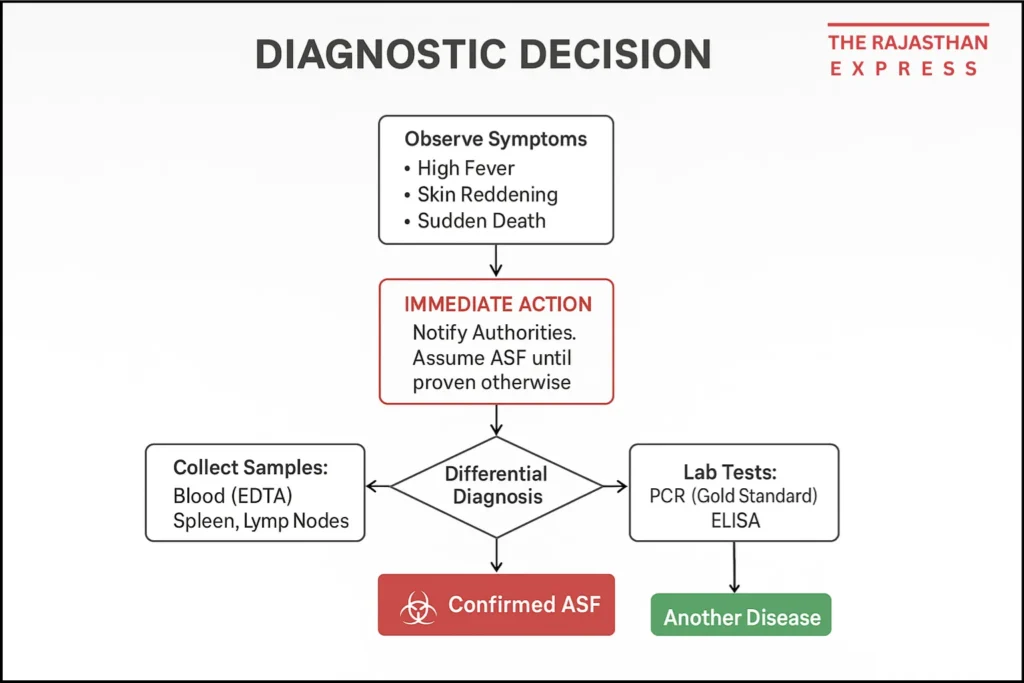
B. Tests for Antibody Identification
- ELISA Test:
- This is the most widely used serological test.
- How it works: It checks whether antibodies against the ASF virus are present in the pig’s blood (serum). If antibodies are present, it means the pig is either currently infected or was infected in the past.
- This test is very useful in pigs that are not showing symptoms or are recovering from the disease.
Scientific Truth and Practical Advice
- Don’t Rely on External Symptoms: It is impossible to differentiate between African Swine Fever and other diseases based on symptoms alone. Therefore, instead of guessing, get tested.
- Time is Precious: As soon as the disease is detected, immediately take the correct samples and send them to an certified laboratory.
- PCR is the Preferred Method: Nowadays, PCR tests are prioritized in most places because they are very fast and accurate.
- Sampling is Critical: Taking the wrong sample or sending it in a improper way can lead to an incorrect test result. Always take samples under the guidance of a veterinarian.
Conclusion: ASF is a devastating disease, and the first step to overcoming it is correct information and rapid diagnosis of African Swine Fever. Laboratory testing is the weapon that can distinguish ASF from its mimicking diseases.
Is There an African Swine Fever Treatment?
It is correct that there is no licensed vaccine in the market. However, research is progressing rapidly. Live-Attenuated Vaccines (LAVs) appear to provide some protection, but they carry the risk of side effects. Work on subunit vaccines is ongoing, which could be safer, but they have not yet been successful in providing complete protection. The biggest challenge in African Swine Fever vaccine development is the virus’s ability to evade the immune response. There is currently no specific treatment for ASF.
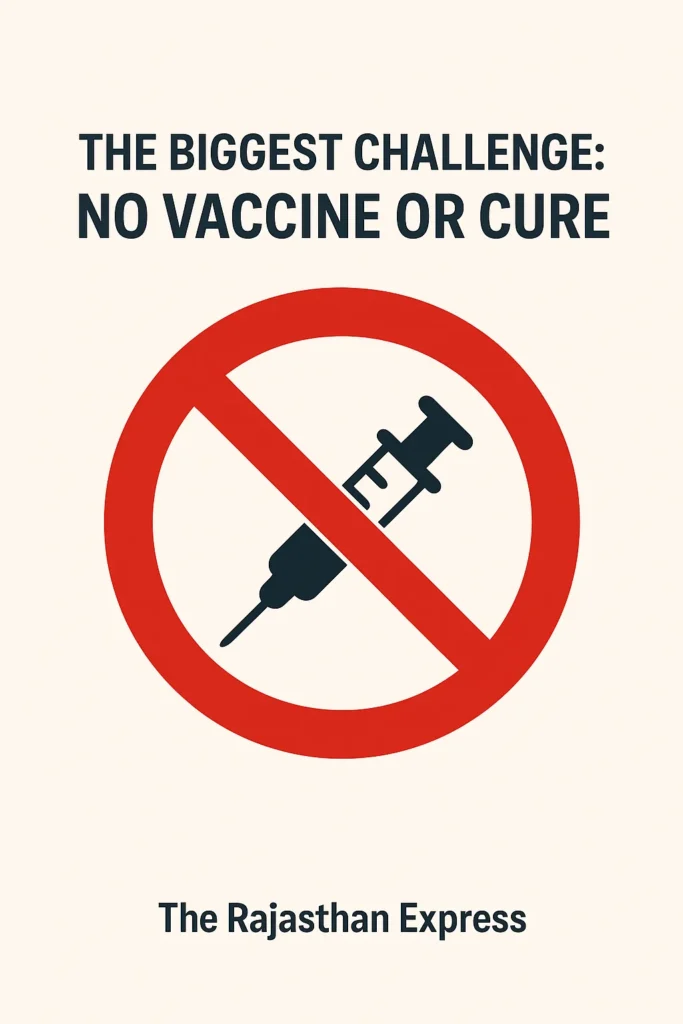
“You can read our detailed guides on the complete poultry vaccination schedule for chickens and broilers and the vaccination schedule for sheep and goats at →
How is African Swine Fever Transmitted? Epidemiology and Spread
The epidemiology of African Swine Fever is extremely complex, depending on the interplay of various hosts, environmental factors, and human activities. To understand its global spread, it is essential to know its three main transmission cycles and various routes of spread.
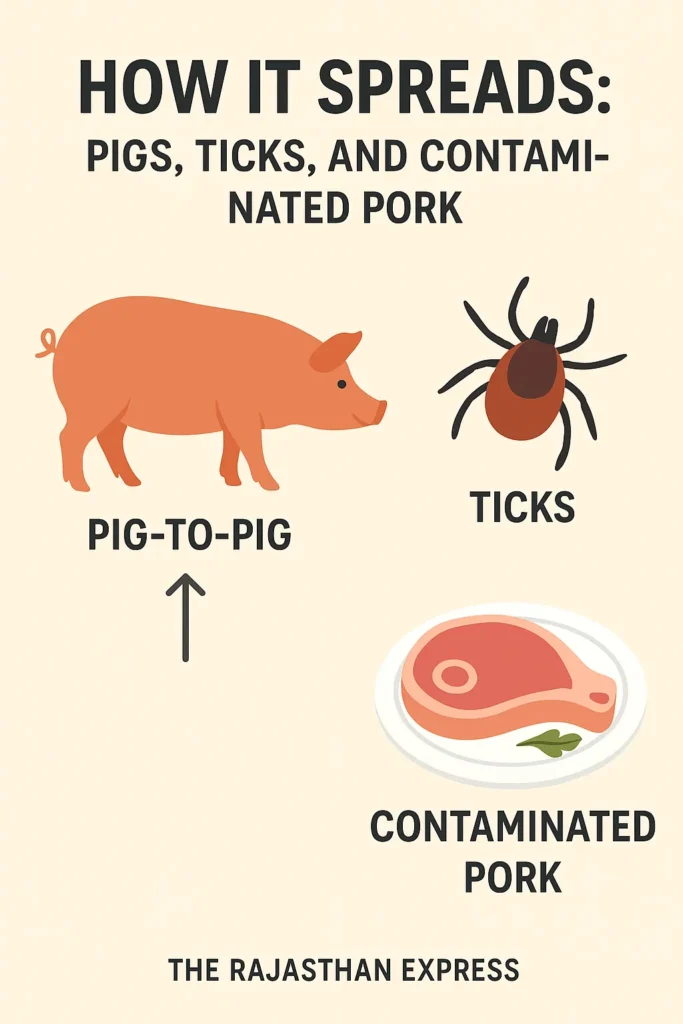
The Three Main Transmission Cycles
- Sylvatic Cycle (Wild Cycle): This cycle is the basis of ASF’s natural transmission in Africa. It involves the virus circulating between African wild suids (like warthogs and bush pigs) and soft-bodied ticks of the Ornithodoros species. Importantly, African wild suids act as natural reservoirs for the virus without showing any symptoms.
- Domestic Cycle: When the virus enters the domestic pig population, the situation becomes severe. The disease spreads rapidly in domestic pigs and takes the form of a severe epidemic with a mortality rate close to 100%.
- Tick-Pig Cycle: In this cycle, ticks act as biological vectors for the virus. These ticks attach to an infected pig’s body for blood-sucking and ingest the virus in the process. When the same tick attaches to a healthy pig and sucks its blood, it transmits the ASF virus. Thus, the tick acts as a biological vector, spreading the disease from one animal to another. The tick can store the virus in its body for a long time, making it a permanent source of the disease.
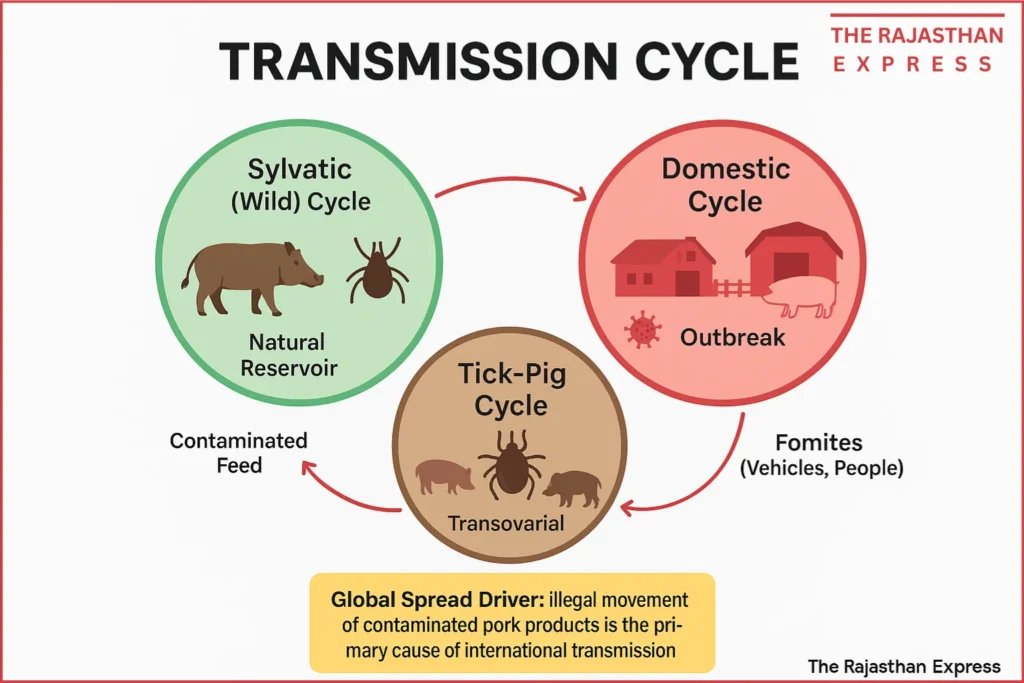
Main Routes of Transmission
The following routes are primarily responsible for the spread of ASF.
| Main Routes of Transmission | |
| Transmission Type | Description |
|---|---|
| Direct Contact | Healthy pigs coming into direct contact with sick pigs. |
| Indirect Contact | Spread through contaminated vehicles, shoes, clothes, equipment, needles (fomites). |
| Contaminated Feed | Feeding infected pork or pork products (garbage). This is the most important cause of global spread. |
| Biological Vector | Spread through the bite of Ornithodoros species ticks. |
| The Rajasthan Express : ASF Transmission Routes | |
How Does African Swine Fever Spread? Transmission and Prevention
Understanding how African Swine Fever is transmitted is the first and most critical step in preventing this devastating disease. With no vaccine available, biosecurity is our only defense.
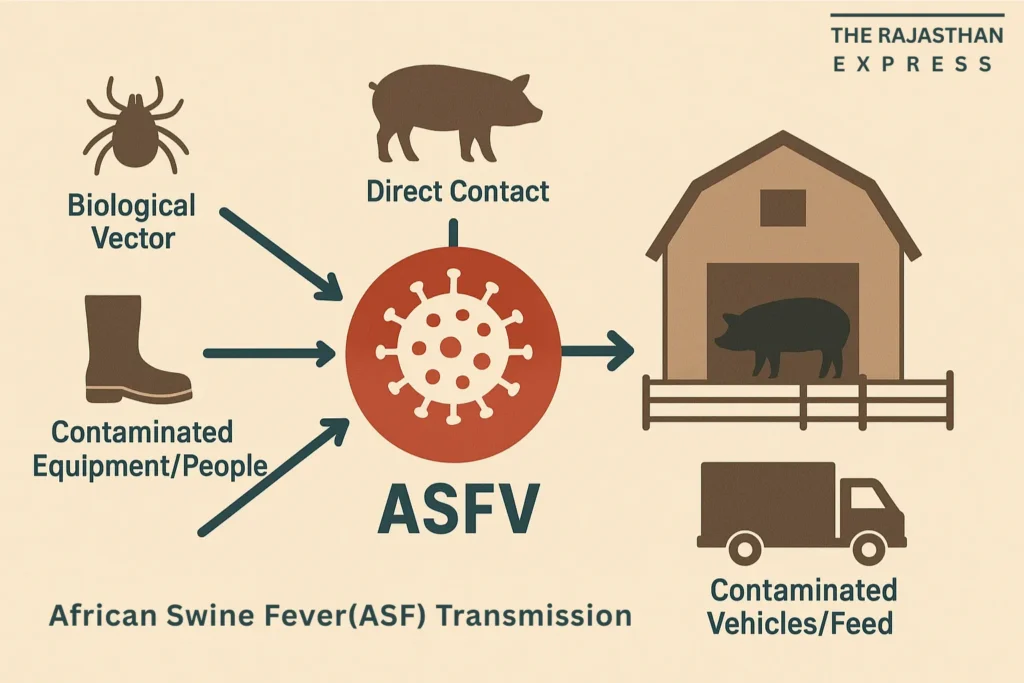
Primary Routes of African Swine Fever Transmission
The African Swine Fever virus (ASFV) is highly contagious and can spread through several direct and indirect pathways. Knowing these is essential for implementing effective control measures.
1. Direct Contact Between Pigs
The most straightforward way ASF spreads is through direct contact between a healthy pig and an infected pig. This includes nose-to-nose contact and exposure to bodily fluids from a sick animal, making it a classic contagious disease.
2. Contaminated Feed (Swill Feeding)
This is one of the most significant routes for global spread. If healthy pigs eat meat or meat products from an infected pig—such as undercooked ham, salami, or other pork waste—they will contract the virus. The virus can survive for months in meat products, making swill feeding extremely dangerous.
3. Biological Vectors: Ticks
Ornithodoros species of soft-bodied ticks are a primary biological vector for the African Swine Fever virus.
- How it works: These ticks attach to an infected pig for a blood meal, ingesting the virus. When the same infected tick later feeds on a healthy pig, it transmits the ASF virus through its saliva.
- Significance: The tick acts as a “living needle,” spreading the disease from one animal to another without any direct contact between pigs.
4. Contaminated Fomites (Indirect Contact)
The virus can hitch a ride on inanimate objects. If a veterinarian, vehicle, or equipment visits an infected farm, the ASF virus can stick to their clothes, shoes, or tools. If these contaminated items are then brought to a healthy farm, the virus can be unknowingly introduced. This is why ASF is considered highly contagious, similar to how Foot and Mouth Disease (FMD) spreads.

The Tick Vector: A Deeper Dive into How Ticks Spread ASF
Think of a tick as a tiny “living syringe” that delivers the disease from one pig to another.
- Step 1 (From an Infected Pig): When a tick attaches to a sick pig to suck blood, it takes the virus into its body. The tick itself becomes infected.
- The Tick’s Role: This infected tick can live for months, even years, harboring the virus inside it.
- Step 2 (To a Healthy Pig): When this same infected tick goes to suck the blood of a healthy pig, it injects the ASF virus into the healthy pig’s body along with its saliva.
- Result: In this way, without any direct contact, the disease spreads from one pig to another.
Key Point: This tick doesn’t just carry the virus; the virus persists in its body for a long time, making the tick a permanent reservoir for the disease.
Advanced Research Report: Ornithodoros Ticks as a Biological Vector
A. Vector Identification and Transmission Mechanism
- Identification: The primary biological vectors for ASF are soft-bodied ticks of the Ornithodoros genus, specifically species like the O. moubata complex in Africa and O. erraticus in the Americas.
- Transmission Mechanism: Transmission occurs via the salivary route. An infected tick injects the virus present in its saliva directly into the pig’s bloodstream during a blood meal. The virus replicates within the tick, keeping it highly infectious for long periods.
- Virus Persistence in Ticks: Ticks are a long-term reservoir. The virus can persist for the tick’s entire lifespan (several years) through two key methods:
- Transstadial Transmission: The virus persists from one life stage (e.g., larva) to the next (e.g., nymph).
- Transovarial Transmission: An infected female tick can pass the virus to her offspring through her eggs. This is crucial for the virus’s survival in the environment, even in the absence of pigs.
B. Scientific Facts: Key Research Findings
- Efficiency of Transovarial Transmission: Research shows the efficiency rate depends on the virus strain and tick species, but it can be as high as 95-100%. This means almost all offspring from an infected female tick will be born with the virus.
- Viral Replication in Tick Tissues: ASFV replicates extensively in the tick’s body, including tissues like the midgut, salivary glands, and ovaries. Replication in the salivary glands enables transmission, while replication in the ovaries ensures transovarial transmission.
- Co-evolution and Low Pathogenicity: ASFV has a co-evolutionary relationship with African wild suids (e.g., warthogs) and Ornithodoros ticks. Due to this long association, the virus typically exists in these hosts without causing fatal disease, creating a stable reservoir that spills over into domestic pigs with devastating effects.
- Implications for Control: The presence of the tick vector means that simply removing infected pigs will not eradicate the disease. The virus will remain hidden in the tick population, causing future outbreaks. Control in these areas must include integrated pest management, acaricide (tick-killing) sprays, and keeping pig habitats tick-free.
Global Situation (as of 2024-25) and Impact on India
- Global Spread: African Swine Fever is no longer confined to Africa. It has spread to several continents, including Europe, Asia, and the Caribbean. In Europe, wild boar have become an endemic reservoir, causing repeated outbreaks in domestic pigs. Recent outbreaks in major pork-producing regions like Italy have caused severe economic concern.
- Situation in India: Several Indian states have been affected by ASF. States like Mizoram have reported massive economic losses, with thousands of pig deaths. It is believed that pigs or pork products illegally imported from neighboring countries like Bangladesh and Myanmar were a primary cause. More recently, states like Kerala and Punjab have also reported ASF cases.
Control Challenges
- Lack of a Vaccine: The complex immune evasion by the virus and the existence of multiple genotypes have so far prevented the development of an effective and safe African Swine Fever vaccine.
- Environmental Stability: The virus’s ability to survive for long periods in waste, fomites, and pork products makes control measures difficult.
- Global Trade and Travel: The illegal trade of infected pork products or contaminated goods carried by travelers commonly spreads the disease from one country to another.
Key Point: Combating ASF requires an integrated approach, including strict biosecurity, rapid diagnosis, proper disposal of infected herds, and international cooperation. Vaccine research remains a top priority.

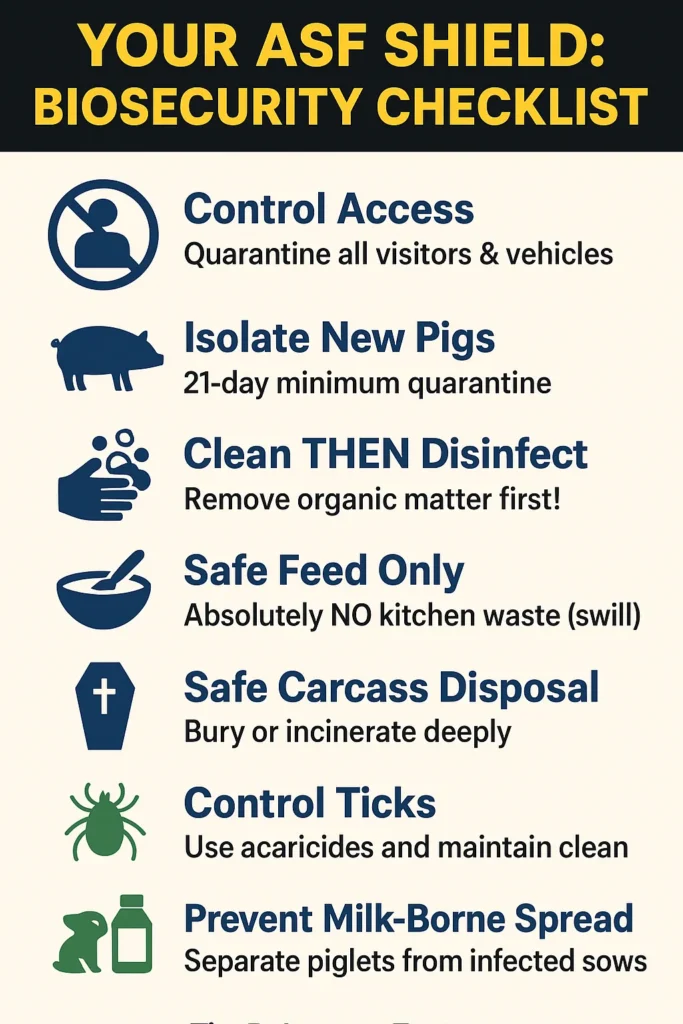

African Swine Fever Prevention: A Practical Biosecurity Guide
African Swine Fever is an extremely lethal and rapidly spreading viral disease. With no effective treatment or vaccine available, prevention relies solely on strict biosecurity and farm management.
1. Control Entry of People and Vehicles
Completely control the movement of external people and vehicles onto the farm. Anyone who must enter should pass through a disinfectant footbath and wear clean farm-specific clothes and boots.
2. Quarantine New Pigs
Do not immediately mix new pigs with the existing herd. Keep them in a separate quarantine area for at least 21 days and monitor them for any signs of disease. Do not incorporate them if any symptoms appear.
3. Rigorous Cleaning and Disinfection
Cleaning and disinfection are paramount.
- Regularly clean sheds, pens, feeders, waterers, and equipment.
- Mandatory spraying of the farm premises with 1% formalin or 2% sodium hypochlorite at least once a week.
Other effective disinfectants for killing ASF virus:
- Sodium Hydroxide
- Hypochlorites
- Ortho-phenylphenol
- Iodine Compounds

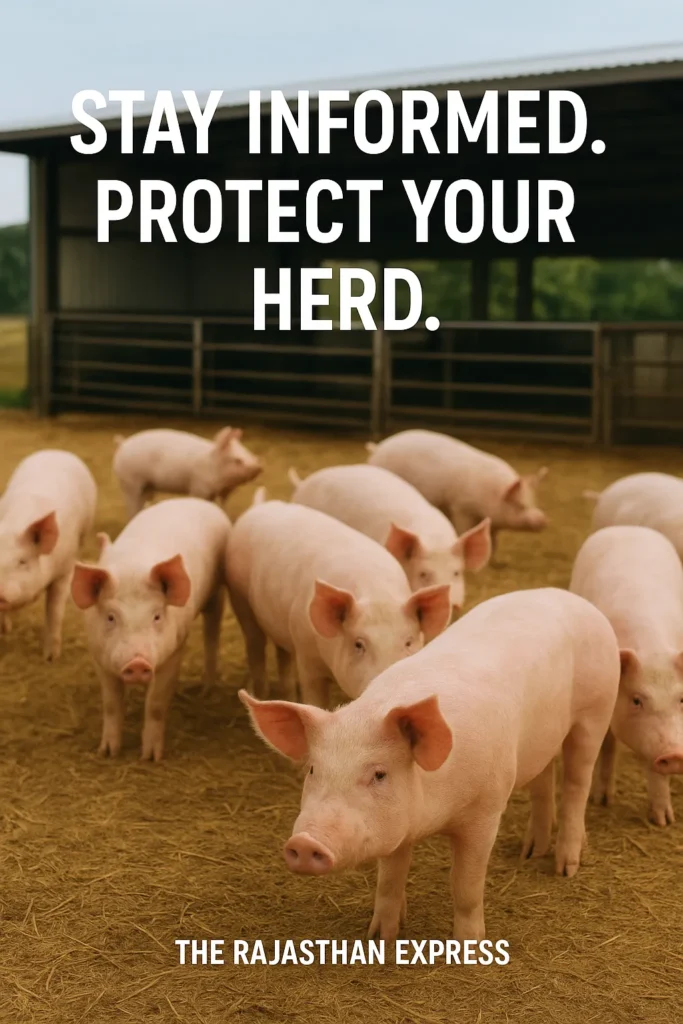
4. Strict Feed Management
Never feed pigs kitchen waste, hotel leftovers, or meat residues, as this is the biggest cause of ASF virus spread. Pigs should only be given clean, balanced, and safe commercial feed.
5. Safe Disposal of Dead Pigs
Pigs that have died from ASF or are suspected cases must be disposed of immediately and correctly. Do not leave them in the open. Incinerate or deeply bury these animals following local guidelines.
6. Preventing Mother-to-Piglet Transmission
The ASF virus can spread from a sick mother to her piglets through milk.
- Action: If a sow is infected, her piglets should be separated immediately and fed only clean milk from healthy sows or a commercial milk replacer.
Advanced Research Report: Milk-Borne Transmission
- Viral Shedding in Milk: ASFV causes a systemic infection. The virus is found in high quantities in the milk of infected sows showing clinical signs. Transmission through the oral route is highly effective.
- Susceptibility of Piglets: Newborn piglets, reliant on colostrum and milk, are highly susceptible due to their underdeveloped immune systems, leading to severe disease and high mortality.
- Scientific Fact – Viral Load: Laboratory studies confirm the viral concentration in the milk of an ASFV-infected sow can be as high as in the blood, making milk a potent transmission medium.
- “Silent Shedding”: During the incubation period, before symptoms appear, an infected sow can start shedding the virus. A seemingly healthy sow can infect her piglets via her milk.
7. Tick Control Measures
- Control the tick population through integrated pest management.
- Protect pigs from tick contact by:
- Providing safe, clean, and well-maintained housing.
- Periodically administering ectoparasitic drugs.
- Regularly bathing pigs to remove any attached ticks.
- Conducting regular disinfection of the farm premises.
Conclusion on African Swine Fever Prevention
The only effective measure for preventing ASFV is strict, multi-layered biosecurity. Adherence to cleanliness, disinfection, secure feed management, and correct disposal of dead animals is non-negotiable. Until a vaccine becomes available, every livestock farmer must rigorously follow biosecurity protocols—this is the ultimate defense against African Swine Fever.
Source By : WOAH
Understand the ASF meaning for pigs. African Swine Fever is a deadly viral disease with no commercial vaccine. Learn key symptoms, how the ASF virus spreads, and the latest 2025 research on treatment and vaccine progress.
THE RAJASTHAN EXPRESS
